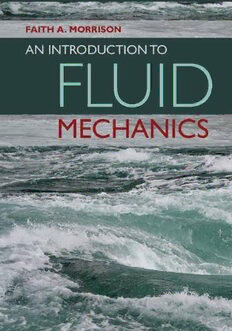Table Of Contentmore information - www.cambridge.org/9781107003538
AN INTRODUCTION TO FLUID MECHANICS
This is a modern and elegant introduction to engineering fluid mechanics enriched
withnumerousexamples,exercises,andapplications.Thegoalofthistextbookisto
introducethereadertotheanalysisofflowsusingthelawsofphysicsandthelanguage
of mathematics. The approach is rigorous, but mindful of the student. Emphasis is
onbuildingengagement,competency,andproblem-solvingconfidencethatextends
beyondafirstfluidscourse.
Thistextdelvesdeeplyintothemathematicalanalysisofflows,becauseknowledge
ofthepatternsfluidsformandwhytheyareformedandthestressesfluidsgenerate
andwhytheyaregeneratedisessentialtodesigningandoptimizingmodernsystems
and devices. Inventions such as helicopters and lab-on-a-chip reactors would never
havebeendesignedwithouttheinsightbroughtbymathematicalmodels.
FaithA.MorrisonisProfessorofChemicalEngineeringatMichiganTechnological
University, where she has taught for 22 years. Morrison’s expertise is in polymer
rheology,inparticularfocusingonmaterialswithstructure,includinghigh-molecular-
weight polymers, block copolymers, hydrogels, and composites. She is the Past
PresidentoftheSocietyofRheologyandEditoroftheRheologyBulletin.Morrison
istheauthorofUnderstandingRheology(2001).
AN INTRODUCTION
TO FLUID MECHANICS
Faith A. Morrison
DepartmentofChemicalEngineering
MichiganTechnologicalUniversity
CAMBRIDGEUNIVERSITYPRESS
Cambridge,NewYork,Melbourne,Madrid,CapeTown,
Singapore,Sa˜oPaulo,Delhi,MexicoCity
CambridgeUniversityPress
32AvenueoftheAmericas,NewYork,NY10013-2473,USA
www.cambridge.org
Informationonthistitle:www.cambridge.org/9781107003538
(cid:2)C FaithA.Morrison2013
Thispublicationisincopyright.Subjecttostatutoryexception
andtotheprovisionsofrelevantcollectivelicensingagreements,
noreproductionofanypartmaytakeplacewithoutthewritten
permissionofCambridgeUniversityPress.
Firstpublished2013
PrintedintheUnitedStatesofAmerica
AcatalogrecordforthispublicationisavailablefromtheBritishLibrary.
LibraryofCongressCataloginginPublicationdata
Morrison,FaithA.
Anintroductiontofluidmechanics/FaithA.Morrison.
p. cm.
ISBN978-1-107-00353-8(hardback)
1.Fluidmechanics. I.Title.
QA901.M67 2012
532–dc23 2011049511
ISBN978-1-107-00353-8Hardback
Additionalresourcesforthispublicationatwww.cambridge.org/us/knowledge/isbn/item6684157/.
CambridgeUniversityPresshasnoresponsibilityforthepersistenceoraccuracyofURLsforexternalor
third-partyInternetWebsitesreferredtointhispublicationanddoesnotguaranteethatanycontenton
suchWebsitesis,orwillremain,accurateorappropriate.
Coverphoto:TheNarutoWhirlpools,Japan,asseenfromatouristcruiseboat.PhototakenbyHellbuny.
ThisbookisdedicatedtomymotherFrancesP.Morrison,
myfatherPhilipW.Morrison,andmyelderbrother
ProfessorPhilipW.Morrison,Jr.
Contents
Preface pagexiii
PART I PREPARING TO STUDY FLOW
1 WhyStudyFluidMechanics? 3
1.1 Gettingmotivated 3
1.2 Quickstart:Themechanicalenergybalance 8
1.2.1 MEBwithnofriction,nowork:Macroscopic
Bernoulliequation 15
1.2.2 MEBwithshaftwork 26
1.2.3 MEBwithfriction 34
1.3 Connectingmathematicstofluidmechanics 49
1.3.1 Calculusofcontinuousfunctions 50
1.3.1.1 Derivatives 50
1.3.1.2 Integrals 54
1.3.2 Vectorcalculus 58
1.3.2.1 Coordinatesystems 61
1.3.2.2 Tensors 67
1.3.2.3 Differentialoperations 70
1.3.2.4 Curvilinearcoordinates 74
1.3.3 Substantialderivative 84
1.3.4 Practicaladvice 91
1.4 Problems 93
2 HowFluidsBehave 106
2.1 Viscosity 106
2.2 Drag 113
2.3 Boundarylayers 118
2.4 Laminarversusturbulentflow:Reynoldsnumber 127
2.5 Aerodynamics:Lift 137
2.6 Supersonicflow 143
2.7 Surfacetension 145
2.8 Flowswithcurvedstreamlines 149
2.9 Magnetohydrodynamics 153
vii
viii Contents
2.10 Particulateflow 154
2.11 Summary 157
2.12 Problems 158
PART II THE PHYSICS OF FLOW
3 ModelingFluids 167
3.1 Motionofrigidbodies 167
3.2 Motionofdeformablemedia 172
3.2.1 Thecontinuummodel 175
3.2.1.1 Fieldvariables 176
3.2.1.2 Thecontinuumhypothesis 181
3.2.1.3 Fluidparticles 184
3.2.2 Control-volumeapproach 187
3.2.2.1 Momentumbalanceonacontrolvolume 190
3.2.2.2 Theconvectiveterm 194
3.2.3 Problemsolvingwithcontrolvolumes 206
3.2.3.1 Microscopiccontrol-volumeproblem 207
3.2.3.2 Macroscopiccontrol-volumeproblem 212
3.3 Summary 218
3.4 Problems 218
4 MolecularFluidStresses 228
4.1 Forcesonacontrolvolume 229
4.2 Stationaryfluids:Hydrostatics 236
4.2.1 Gases 237
4.2.2 Liquids 241
4.2.3 Pascal’sprinciple 261
4.2.4 Staticfluiddevices 271
4.2.4.1 Manometers 271
4.2.4.2 Hydrauliclifts 277
4.3 Fluidsinmotion 283
4.3.1 Totalmolecularstress 284
4.3.1.1 Stresstensor 286
4.3.1.2 Stresssignconvention 298
4.3.2 Isotropicandanisotropicstress 302
4.4 Free-surfacestresseffects 320
4.5 Problems 333
5 Stress-VelocityRelationships 346
5.1 Simpleshearflow 348
5.1.1 Velocityfield 350
5.1.2 Stressfield 351
5.1.3 Viscosity 360
5.2 Newtonianfluids 364
5.2.1 Theconstitutiveequation 369
5.2.2 Usingtheconstitutiveequation 379

